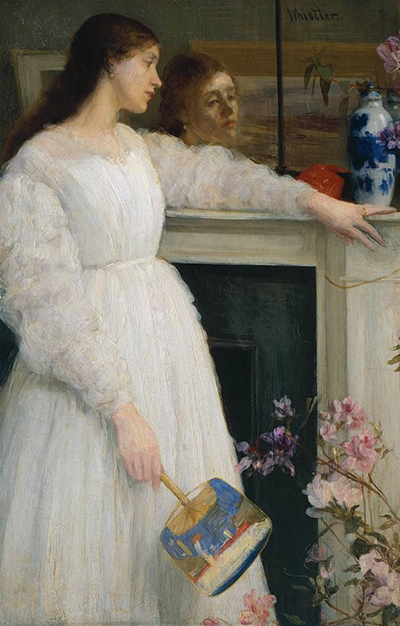The Symphony in White No. 2: The Little White Girl is a 76 cm × 51 cm (30 in × 20 in) oil on canvas piece painted by James Abbott McNeill Whistler in the winter of 1864 and was displayed in a summer exhibition at the Royal Academy of Arts in Piccadilly, London the very next year.
Like The Symphony in White No. 1, the model for The Little White Girl was Joanna Hiffernan. The original frame featured a poem entitled Before the Mirror by Whistler's friend Algernon Charles Swinburne, a friend of Whistler's. The Little White Girl is held as a primary example of Whistler's concern that painting should be done to highlight the formal elements like light, color, shade, shapes, etc. and to put the content of the painting in the background. Whistler surmised this motto as "art for art's sake". The dominant formal shapes of Hiffernan's gown and the lines of the fireplace and the mirrors emphasizes a vertical composition.
The hand holding the fan, the hand resting on the mantelpiece, the flow of the gown and the direction of the blooming flowers complicate this vertical composition by giving a diagonal direction from top left to bottom right. The Little White Girl features the typical method of layered painting that critics found reminiscent of the Japonisme technique. The bottom layers would contain only the dominant shapes in drab brown and grey, while the top layers would contain the first flesh-colored shades, with the colors of the actual painting at the top. This layered approach gives the piece a livelier appearance. Unlike the first Symphony in White, this piece has softer contrasts and harder geometrical shapes.
The face and the reflection in the mirror aren't too distinct from each other in shades. The color in the fan and on the vase are also softly contrasted from everything around it. This drives more attention to the Little White Girl's posture and position in the piece than the colors that surround her. The softer contrasts contribute to Whistler's belief that art should suggest, not tell. Despite lukewarm reception from critics, The Little White Girl generated interest in the Universal Exhibition in Paris in 1900. In 1919, Arthur Studd, the then owner of the piece bequeathed it to the National Gallery. In 1951, it was relocated to Tate Gallery, London.




